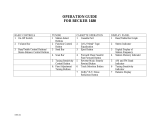Blaupunkt RCM 82 User manual
- Category
- Car media receivers
- Type
- User manual
This manual is also suitable for
Blaupunkt RCM 82 is your key to a world of quality sound. This easy-to-use car stereo is packed with features that will enhance your driving experience. With its built-in CD player, cassette deck, and radio, you'll have a variety of options for listening to your favorite music. The RCM 82 also features a number of sound-enhancing features, such as bass and treble controls, and a loudness button that will boost the bass frequencies at low volumes. Whether you're commuting to work or on a road trip, the Blaupunkt RCM 82 will provide you with hours of listening enjoyment.
Blaupunkt RCM 82 is your key to a world of quality sound. This easy-to-use car stereo is packed with features that will enhance your driving experience. With its built-in CD player, cassette deck, and radio, you'll have a variety of options for listening to your favorite music. The RCM 82 also features a number of sound-enhancing features, such as bass and treble controls, and a loudness button that will boost the bass frequencies at low volumes. Whether you're commuting to work or on a road trip, the Blaupunkt RCM 82 will provide you with hours of listening enjoyment.


















-
 1
1
-
 2
2
-
 3
3
-
 4
4
-
 5
5
-
 6
6
-
 7
7
-
 8
8
-
 9
9
-
 10
10
-
 11
11
-
 12
12
-
 13
13
-
 14
14
-
 15
15
-
 16
16
-
 17
17
-
 18
18
Blaupunkt RCM 82 User manual
- Category
- Car media receivers
- Type
- User manual
- This manual is also suitable for
Blaupunkt RCM 82 is your key to a world of quality sound. This easy-to-use car stereo is packed with features that will enhance your driving experience. With its built-in CD player, cassette deck, and radio, you'll have a variety of options for listening to your favorite music. The RCM 82 also features a number of sound-enhancing features, such as bass and treble controls, and a loudness button that will boost the bass frequencies at low volumes. Whether you're commuting to work or on a road trip, the Blaupunkt RCM 82 will provide you with hours of listening enjoyment.
Ask a question and I''ll find the answer in the document
Finding information in a document is now easier with AI
Related papers
-
Blaupunkt RCM 126 User manual
-
Blaupunkt RCM 85 User manual
-
Blaupunkt Mnchen RDM 169 User manual
-
Blaupunkt Toronto RDM 128 User manual
-
Blaupunkt LONDON RDM 104 Operating Instructions Manual
-
Blaupunkt RCM 104 A User manual
-
Blaupunkt Madeira RCR85 Owner's manual
-
Blaupunkt KIEL RD 104 User manual
-
Blaupunkt RCM 126 User manual
-
Blaupunkt PHOENIX CD70 User manual
Other documents
-
Becker 780 Operating instructions
-
VDO CD 413-24V Owner's manual
-
 Becker Designed Car Stereo System 1480 User manual
Becker Designed Car Stereo System 1480 User manual
-
Verona CR 43 User manual
-
VDO CD 3300 - Owner's manual
-
Viking TMC 148 User manual
-
Sanyo FXR-303GB Operating Instructions Manual
-
Volkswagen BR-23 Operating Instructions Manual
-
Sanyo FX22 User manual
-
echoflex 8DC-5896-KSS Installation guide


















